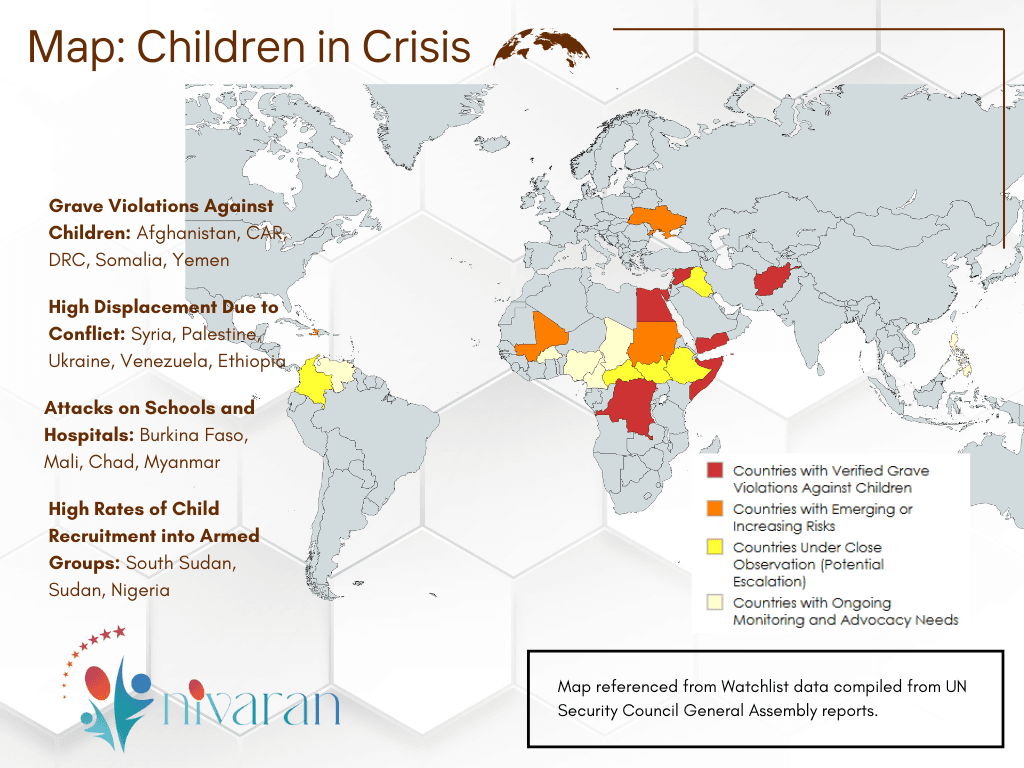Children at the Frontlines: Safeguarding Young Lives Amid Global Crises
With over 473 million children now living in conflict zones, the need to protect vulnerable young lives is more urgent than ever. Discover how humanitarian aid, education initiatives, and policy advocacy are crucial to safeguarding their futures and fostering hope amid crisis.

In recent years, the world has witnessed a disturbing rise in the number of children living amidst armed conflicts and crises. As of late 2024, nearly one in five children globally—over 473 million—reside in areas affected by conflict, marking the highest number since World War II (The Guardian). This stark statistic underscores the urgent need to address the multifaceted challenges these children face.
Case Studies: Children in Conflict Zones

Gaza Strip
The Gaza Strip has endured significant turmoil, especially following the conflict that began in October 2023. Reports indicate that over 46,600 Palestinians lost their lives, with more than half being women, children, or the elderly (Reuters). The extensive destruction of infrastructure, including homes and schools, has left countless children homeless and deprived of education. The psychological trauma inflicted on these young minds is immeasurable, with many witnessing the loss of family members and friends.
Afghanistan
Between July and September 2023, the United Nations documented at least 400 grave violations against children in Afghanistan. These violations included killings, maiming, and recruitment into armed groups (Watchlist). The volatile security situation continues to endanger children's lives, disrupt their education, and limit access to essential healthcare services.
Haiti
In 2024, Haiti faced escalating crises, with armed gangs controlling significant territories. This instability has severely impacted children, exposing them to violence, displacement, and a lack of basic necessities (World Vision). The breakdown of law and order has left many children vulnerable to exploitation and deprived of their right to a safe and nurturing environment.
The Broader Impact
The repercussions of such conflicts on children are profound:
- Health Risks: Children in conflict zones are at heightened risk of malnutrition, disease, and inadequate medical care. The destruction of healthcare facilities exacerbates these challenges, leading to preventable deaths and long-term health issues.
- Educational Disruptions: Armed conflicts often result in the closure or destruction of schools, denying children their right to education. This not only hampers their personal development but also affects the future socio-economic fabric of their communities.
- Psychological Trauma: Exposure to violence, loss, and instability inflicts deep psychological scars. Without proper support, these traumas can lead to long-term mental health issues, affecting children's ability to lead productive lives.
The Imperative to Act
Protecting children in conflict zones requires a concerted global effort:
- Humanitarian Aid: Immediate provision of food, shelter, healthcare, and psychological support is crucial. Organizations like UNICEF and Save the Children are at the forefront, delivering life-saving assistance to affected children.
- Education Initiatives: Establishing temporary learning spaces and rebuilding schools can provide a semblance of normalcy and hope. Education not only imparts knowledge but also serves as a protective mechanism against exploitation.
- Policy Advocacy: International bodies must hold perpetrators accountable and advocate for the protection of children's rights. Strengthening legal frameworks and ensuring adherence to international humanitarian laws are essential steps in safeguarding children.
- Community Rehabilitation: Investing in community-based programs that support families and children can foster resilience and aid in recovery. These programs should focus on mental health support, vocational training, and social cohesion to rebuild the social fabric torn apart by conflict.
A Call to Action
The plight of children in conflict zones is a stark reminder of the devastating human cost of war and instability. As global citizens, it is our collective responsibility to protect the most vulnerable and ensure they have the opportunity to thrive. By addressing their immediate needs and working towards sustainable peace, we can help build a future where every child is safe, healthy, and educated.
Together, we can rebuild lives and communities. Explore Nivaran's commitment towards child welfare across the globe.